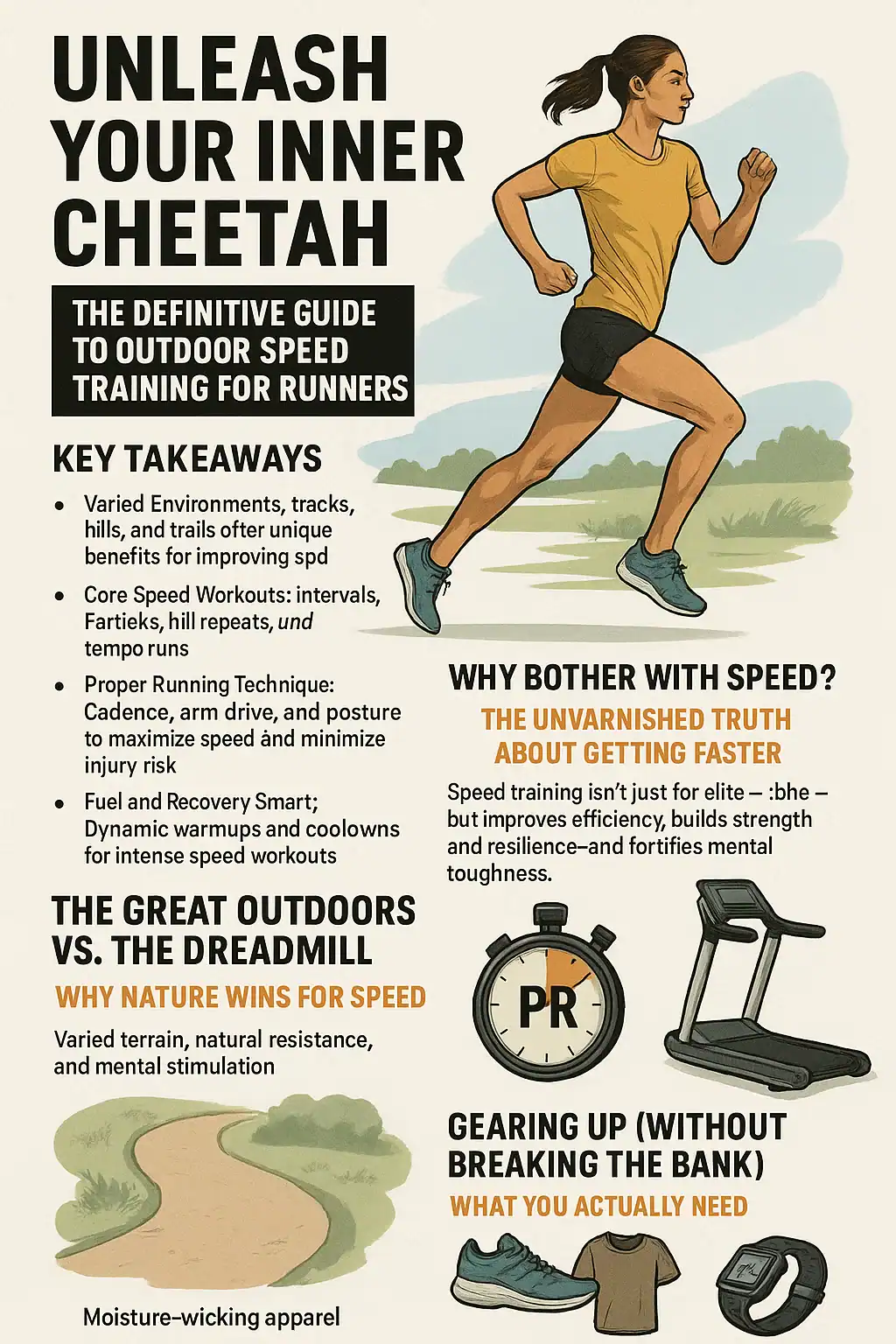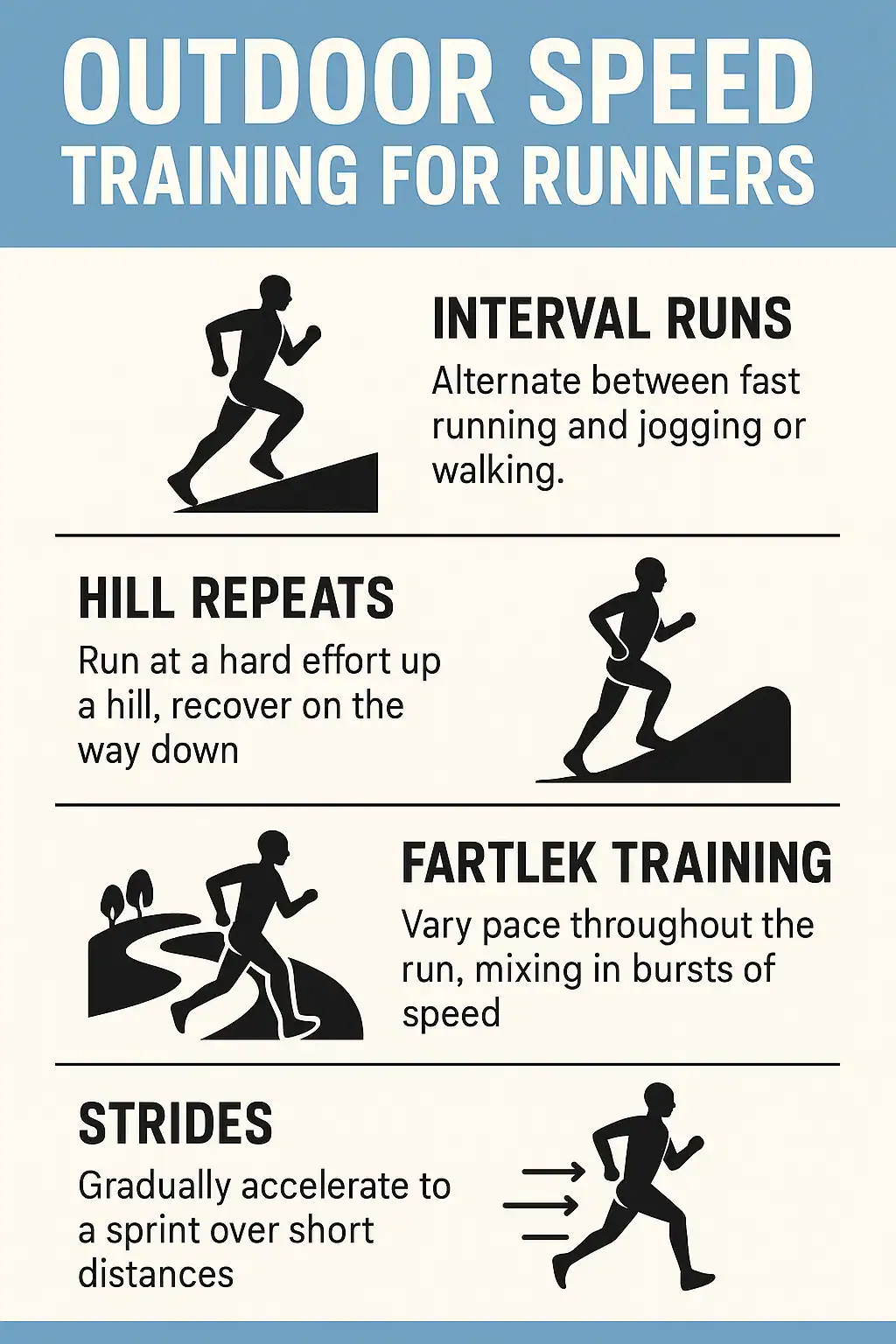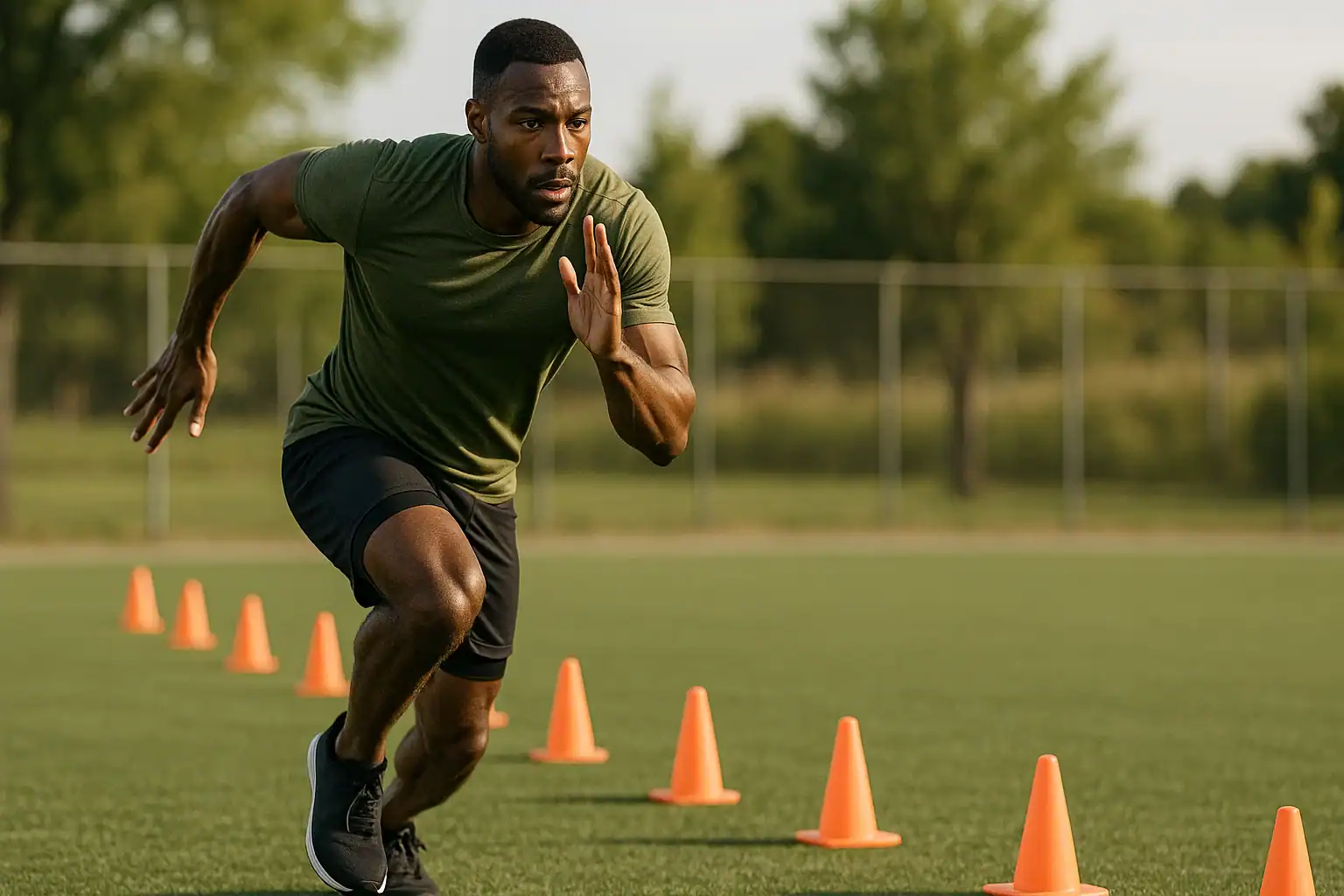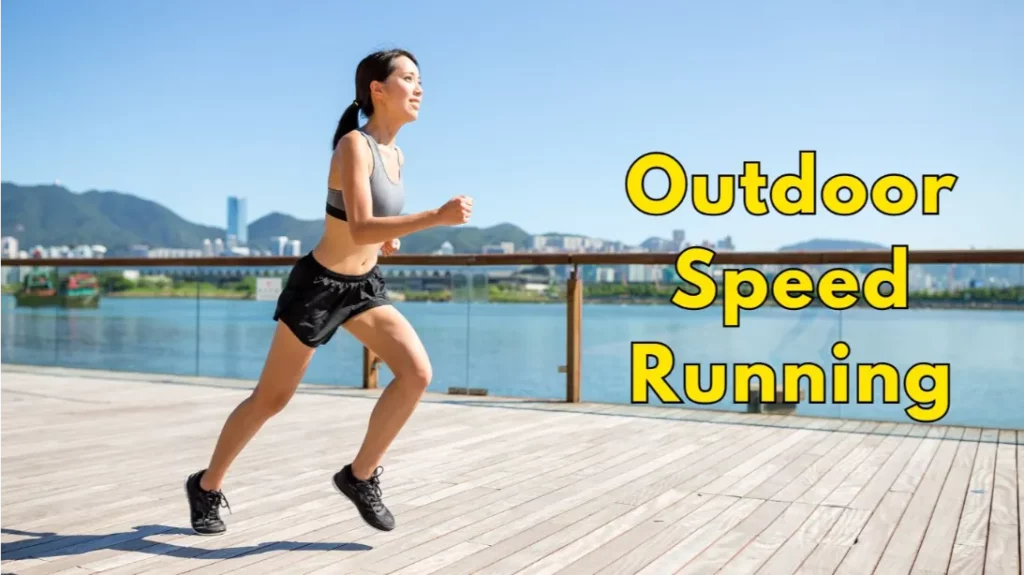Imagine this: in just four to six weeks, you could be running with up to 6% greater efficiency—covering more ground with the same effort, or holding a faster pace without gasping for air. That’s not a sales pitch; it’s a documented outcome of targeted speed training.
Outdoor Speed Training for Runners is a systematic approach using varied natural environments—tracks, parks, hills, trails—to execute specific running exercises and drills. Its core purpose is to dramatically enhance your running speed, power, and efficiency, backed by research showing improvements in running economy, anaerobic endurance, and even injury resilience when done correctly.

Key Takeaways:
- Get Faster, Period: Improve acceleration and top-end speed.
- Run Stronger, Longer: Better running economy means less effort at any pace.
- Build Injury Resistance: Strengthens muscles, bones, and connective tissues.
- Boost Mental Edge & Mood: Cognitive benefits from outdoor, high-intensity work.
- Torch Fat More Effectively: High-intensity efforts elevate metabolism (afterburn effect).
- Mimic Real Race Conditions: Hills, turns, and variable surfaces prepare you better.
The Science of Speed: Understanding the “Why”
Critical thinking starts with understanding why these methods work.
- Stronger Stride & Muscle Activation: Speed work engages more muscle fibers through a fuller range of motion. This isn’t just about leg speed; it’s about power from the ground up.
- Improved Running Economy: High-intensity training teaches your body to use oxygen more efficiently. Studies show up to 6% improvement in weeks, meaning you can run faster or longer with the same effort. Think about that gain.
- Enhanced Anaerobic Endurance: The first 30-40 seconds of any run are largely anaerobic. Speed training directly improves this critical phase.
- Cognitive Boost: Exercising outdoors, especially with the focus required for speed, enhances mood and cognitive function. It’s not just physical.
Core Principles: The Foundation of Fast (Non-Negotiable)
To truly benefit, you must adhere to these principles. Don’t just go through the motions; understand why they are critical.
- Technique First: Proper form (posture, arm drive, foot strike) maximizes efficiency and reduces wasted energy. Poor form under high intensity is a recipe for injury.
- Build Strength & Power: Explosive movements require a strong foundation, particularly in the legs and core. This isn’t optional; it’s integral to speed and injury prevention.
- Consistency is King: Sporadic efforts yield sporadic results. Aim for 1-2 dedicated speed sessions weekly for beginners, potentially 2-3 for advanced runners, allowing for adaptation.
- Recovery is Training: Insufficient recovery negates hard work and increases injury risk. Sleep, nutrition, and rest days are as crucial as the sprints themselves.
Biomechanics: The Engineering of Your Speed
Think of your body as a high-performance machine.
- Core Strength is Central: A strong core maintains torso alignment and allows for faster arm action, which directly drives leg turnover. If your core is weak, you’re leaking power.
- Arm Drive Dictates Leg Speed: Compact, powerful arm swings help increase your stride frequency.
- Foot Strike Efficiency: Aim for a midfoot strike landing under your center of mass. Overstriding is a braking force.
High-Impact Outdoor Speed Workouts: The “How-To”

Always precede these with a 10-15 minute dynamic warm-up (leg swings, high knees, butt kicks, torso twists) and follow with a 10-minute cool-down (easy jogging and static stretches). Explore dynamic warmup routines for outdoor running and cool down stretches for outdoor running for specific examples.
Sprint-Based Workouts (Maximum Velocity & Power)
- Pure Hill Sprints:
- What: Builds explosive power and challenges form.
- How: Mark ~50m up a moderate hill. Sprint at MAX effort. Walk down slowly (recovery should be 4-5x the sprint duration). Complete 5 reps. Rest 3 mins. Repeat for 2-3 total sets (blocks).
- Critical Thought: Why hills? They force high knee lift and powerful push-off, exaggerating good form elements while providing natural resistance.
- “Beach Muscle” Sprint Combo (Full Body Power & Fat Burn):
- What: Combines speed with functional strength.
- How: Every Minute On the Minute (EMOM): Run 100m at near-max speed (can be 50m out-and-back). Immediately perform 5 pull-ups & 5 push-ups. Rest the remainder of the minute. Repeat for a set number of minutes (e.g., 10-15 minutes).
- Critical Thought: This challenges cardiovascular recovery and mimics the total body fatigue experienced in many sports.
Interval & Ladder Training (Speed Endurance & VO2 Max)
- The “Speed Ladder” (Building Endurance with Speed):
- What: Varied interval lengths to challenge different energy systems.
- How: After warm-up, run intervals at 7-8/10 effort: 30s, 60s, 2min, 3min, 2min, 60s, 30s. Recovery is typically equal to or slightly less than the work interval for shorter efforts, and 50-75% for longer.
- Critical Thought: This structure teaches pacing and how to handle speed when already partially fatigued.
- VO2 Max Ladder (Targeting Aerobic Power):
- What: Designed to improve your body’s maximum oxygen uptake.
- How (by Joanna Zeiger): Warm-up. Then 2-4 sets of:
- 3 x (30s fast / 30s easy jog)
- 2 x (45s fast / 45s easy jog)
- 1 x (60s fast / 2 min easy jog)
Fast intervals at 5k pace to 15s/mile faster.
- Critical Thought: This type of workout directly stresses your aerobic system’s upper limits, forcing adaptation.
Fartlek Training (“Speed Play” – Adaptable & Intuitive)
- What: Unstructured bursts of speed within a continuous run. Excellent for beginners or varied terrain.
- How: During a 20-40 minute run, incorporate spontaneous faster segments. Examples:
- Sprint between two lampposts, jog to the next.
- Run hard for 1 minute, jog for 2 minutes. Repeat.
- For 5K training: 100m speed bursts within a 3-mile run.
- Critical Thought: Fartleks develop your ability to change pace quickly and recover on the move, crucial for races with surges.
Designing Your Program: Smart Structuring for Success
- Periodization – The Blueprint: Effective training isn’t random. It’s planned.
- Macrocycle: Your entire season/long-term goal.
- Mesocycle: Specific training blocks (e.g., 4-6 weeks of base building, then 4-6 weeks of speed focus).
- Microcycle: Your typical training week.
This structured approach of overload and adaptation is fundamental to long-term improvement.
- Beginners: Start with ONE dedicated speed session per week. Follow with an easy or rest day. Your body needs time to adapt. Example: After a base of easy runs, add a Fartlek session.
- Advanced: Can progress to TWO speed workouts weekly, ensuring adequate recovery (e.g., Tuesday intervals, Friday hill sprints, with easy runs or rest in between).
- Progressive Overload: Gradually increase ONE variable: intensity (run faster), volume (more reps/longer duration), or decrease rest. Don’t increase all at once. A 10-15% increase in one parameter is a safe guideline. This is essential for how to get better at running.
Essential Support Systems for Speed
Gear:
-
- Shoes: Responsive, lighter shoes can aid speed work. Check out best running shoes for outdoor workouts.
- Apparel: Moisture-wicking running clothes for comfort.
Nutrition & Hydration:
-
- Fuel: Adequate carbohydrates are essential for high-intensity work. Understand why carbs are good for runners.
- Repair: Protein post-workout aids muscle recovery.
- Hydration: Crucial. Fluid loss impairs performance. Fluid intake above ~10 mL/kg body weight can increase high-speed running distance by ~4%. Develop a hydration strategy, especially for longer or warmer sessions. This links to overall nutrition and hydration in running performance.
Recovery & Injury Prevention:
-
- Warm-up/Cool-down: Non-negotiable.
- Stretching: Dynamic before, static after.
- Sleep: Critical for hormone regulation and tissue repair.
- Listen to Your Body: Differentiate good effort from bad pain. Pushing through injury leads to setbacks. If you are a beginner, it’s important to know the risks of running as a beginner.
A Sample Outdoor Speed Training Session
Here’s an example workout that you can try on an outdoor track:
- Warm-Up (10 minutes):
Light jog followed by dynamic stretches (leg swings, high knees). End with foam rolling to loosen tight muscles. - Main Set (Interval Training):
- 4 × 400-meter intervals at an all-out pace
- 30-second rest between intervals
- Focus on maintaining proper form with a consistent effort level
- Cool-Down (10 minutes):
- Slow jog or brisk walk
- Static stretches focusing on the quads, hamstrings, and calves
- Use active recovery techniques such as light stretching to lower your heart rate
Note: Adjust the number of repeats and intensity based on your current fitness level. Beginners may start with fewer repeats and longer recovery periods, ensuring there is minimal risk of injury.
Putting It All Together: Your Action Plan

Follow these strategic steps to revolutionize your outdoor speed training:
- Define Your Goals:
Establish whether you want to sharpen your race pace, build endurance, or simply become a faster runner. - Assess Your Fitness Level:
Use tools like a pace calculator and monitor your heart rate to set realistic targets. - Choose the Right Workouts:
Blend interval training, ladder workouts, and fartlek sessions to target different aspects of performance. - Plan Your Week:
Design a weekly training plan that includes speed workouts, strength training, and active recovery days to minimize injury risk. - Monitor Progress:
Track your performance metrics—running pace, heart rate zones, rest periods, and recovery time—to fine-tune your routine. - Stay Mentally Tough:
Embrace the mental challenge—each workout is a chance to build resilience and refine your running form.
Tracking Your Progress (Optional but Insightful)
While not strictly necessary for “no-fluff,” if you’re data-driven:
- GPS Watches: Track pace, distance, and intervals. Some systems like Polar Team Pro or Playermaker offer advanced metrics, though accuracy can vary. For example, a good Garmin Instinct review for outdoor trainers might be useful.
- Manual Logging: Note your workout, how you felt, and your times. This qualitative data is valuable.
The Critical Takeaway

You now have the blueprint. We’ve established that incorporating Outdoor Speed Training for Runners isn’t just about feeling the burn; it’s about unlocking scientifically-backed gains, like that potential 6% improvement in running efficiency which translates to real-world faster times or easier efforts. But knowledge without action is just potential. The true “helpfulness” of this guide ignites when you translate these principles and workouts into your personal running reality.
Think Critically, Act Deliberately:
This isn’t a one-size-fits-all prescription. Your journey to faster running is unique.
- Honest Self-Assessment: Where are you now? Are you consistently running? Are you injury-free? If you’re new to running, here are 11 tips to help you get started – master the basics before diving deep into intense speed work. Your starting point dictates your initial approach.
- Pick ONE Focus to Start: Don’t try to implement everything at once. Perhaps it’s adding a Fartlek session to one run a week. Or, if you have a good base, introducing structured intervals on a local track. Master one change before adding another.
- Form Before Force: Before chasing blistering paces, internalize the cues for good proper running form and technique outdoors. Film yourself. Feel the difference when you run tall versus hunched. This awareness is a skill that pays dividends.
- Recovery IS Productive: This cannot be overstressed. Are you really taking your easy days easy? Are you prioritizing sleep? Your body rebuilds and gets stronger during recovery, not during the hard effort itself. Consider what running recovery methods you can consistently integrate.
- Listen, Truly Listen, to Your Body: This isn’t about being soft; it’s about being smart. Distinguish between the discomfort of hard work and the warning signs of injury. This intuition develops over time and is crucial for sustainable progress. Understand how to prevent common outdoor running injuries.
- Embrace the “Experiment of One”: What works best for elite athletes or your running buddy might need tweaking for you. Track your workouts, note how you feel, and don’t be afraid to adjust your plan. This is your path to improving your running performance.
References
- https://www.ncbi.nlm.nih.gov/pmc/articles/PMC10574827/ (Validity of tracking systems)
- https://www.runnersworld.com/training/a20716909/speed-training-health-benefits/ (General benefits, injury reduction, running economy)
- https://athletesacceleration.com/8-things-know-speed-training/ (Biomechanics, core strength)
- https://www.trainingpeaks.com/blog/macrocycles-mesocycles-and-microcycles-understanding-the-3-cycles-of-periodization/ (Periodization)
- https://pubmed.ncbi.nlm.nih.gov/37002685/ (Hydration and performance)
- https://www.theathletesfoot.com.au/myfit/a-guide-to-speed-training.html (Core principles, technique, recovery)
- https://www.coachweb.com/bodyweight-workouts/5678/outdoor-fitness-training-plan/page/0/4 (Sprint workouts, “Beach muscle”)
- https://www.menshealth.com/uk/workouts/a61645582/outdoor-bodyweight-and-sprint-workout/ (Cognitive benefits of outdoor exercise)
- https://run.outsideonline.com/training/workouts/speed-workouts-you-can-do-anywhere/ (Speed Ladder, VO2 Max Ladder, race condition mimicry)
As a veteran fitness technology innovator and the founder of GearUpToFit.com, Alex Papaioannou stands at the intersection of health science and artificial intelligence. With over a decade of specialized experience in digital wellness solutions, he’s transforming how people approach their fitness journey through data-driven methodologies.
